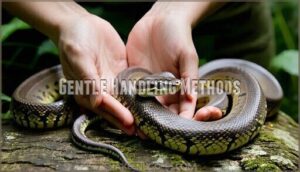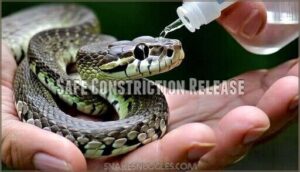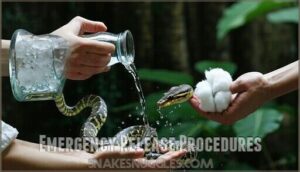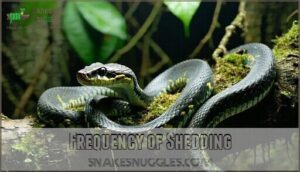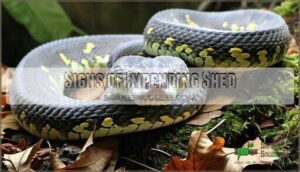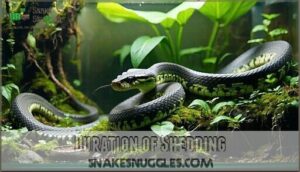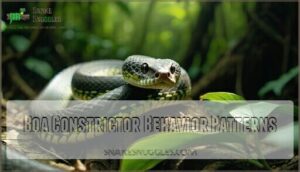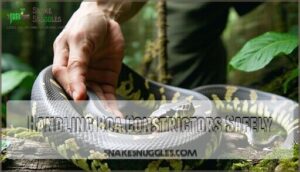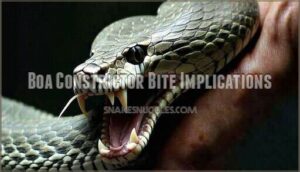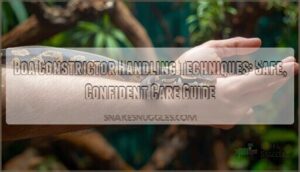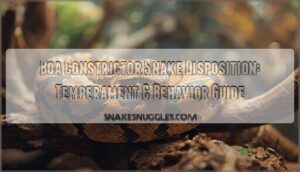This site is supported by our readers. We may earn a commission, at no cost to you, if you purchase through links.
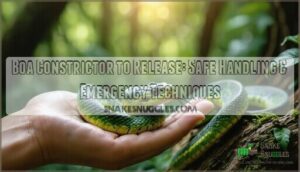
Instead of pulling away (your natural instinct), gently push the snake’s head toward its body or pour cold water on its face.
The cold water method is surprisingly effective because it mimics their natural response to temperature changes.
You can also try a small amount of mouthwash, which they find unpleasant.
Remember, boas aren’t trying to hurt you – they’re just being defensive.
The key is staying calm and using the right technique.
There are several other proven methods that can save you from a tight spot.
Table Of Contents
- Key Takeaways
- Boa Constrictor Release Techniques
- Constrictor Shedding Process
- Boa Constrictor Behavior Patterns
- Handling Boa Constrictors Safely
- Boa Constrictor Bite Implications
- Frequently Asked Questions (FAQs)
- What to do if Python constricts you?
- How long does it take for a boa constrictor to shed?
- Do boa constrictors recognize their owners?
- How to make a constrictor let go?
- How tight can a boa squeeze?
- Can the boa constrictor pressure separate?
- How fast can a boa constrictor strike?
- How does a boa constrictor hunt in the wild?
- What are common diseases affecting boa constrictors?
- How long is the lifespan of a boa constrictor?
- Conclusion
Key Takeaways
- Don’t pull away when constricted – Push the snake’s head toward its body or pour cold water on its face instead of yanking, which only makes the grip tighter.
- Use cold water or rubbing alcohol for quick release – These methods disrupt the snake’s natural responses and encourage it to let go without causing harm to either of you.
- Start unwinding from the tail, not the head – Work systematically from tail to head while supporting the snake’s body weight throughout the process.
- Stay calm and move deliberately – Panic triggers defensive responses in boas, so maintain confident, slow movements and remember they’re not trying to hurt you.
Boa Constrictor Release Techniques
When you’re wrapped up in a boa’s embrace, you’ll need proven techniques to encourage your snake to let go without causing stress or injury to either of you.
These release methods range from gentle coaxing for routine handling to emergency procedures that can save lives when things go sideways.
Gentle Handling Methods
Understanding boa temperament is your first step toward stress-free snake handling.
These gentle giants respond well to calm, confident approaches that respect their nature.
Here’s your roadmap to gentle handling success:
- Start with gradual acclimation – let your boa adjust to your presence before attempting contact
- Use secure grips behind the head and mid-body for ideal control
- Move slowly and deliberately to avoid triggering defensive responses
- Maintain handler confidence through consistent, predictable movements
- Keep sessions brief initially, reducing stress for both you and your snake
For added safety, consider using a specialized handling tool.
Safe Constriction Release
When your boa constrictor decides to give you an unwanted hug, don’t panic.
Apply mouthwash or rubbing alcohol near its mouth for quick snake release. Pour cold water over its face to disrupt constriction while avoiding drowning.
When gentle persuasion fails, cold water and rubbing alcohol become your best friends for emergency boa release.
Start unwinding from the tail, supporting the body throughout. Understanding their constriction pressure exerted is also vital for safe handling and ensuring both your safety and the snake’s well-being.
Emergency Release Procedures
When gentle methods fail, you’ll need immediate action to save yourself or others.
Quick disconnects become lifesavers when a boa constrictor won’t release its grip.
Emergency situations demand swift first aid responses:
- Cold water shock – Pour ice-cold water directly on the snake’s head
- Alcohol application – Dab rubbing alcohol on the snake’s mouth area
- Professional reptile rescue – Call emergency snake relocation services immediately
Constrictor Shedding Process
You’ll notice your boa constrictor becomes less responsive and may refuse food when it’s preparing to shed—this natural process happens every few months and shouldn’t alarm you.
Understanding the shedding timeline helps you anticipate when your snake will be more defensive and less cooperative during handling sessions, which can be a defensive period.
Frequency of Shedding
Young boa constrictors shed every 4-6 weeks like clockwork, but adults slow down to 3-4 times yearly.
Your snake’s shedding frequency depends on age influence, diet impact, and environmental factors like temperature and humidity.
Fast-growing juveniles burn through their skin faster than mature adults, and health indicators show stressed snakes may shed irregularly, disrupting normal reptile care routines.
Maintaining proper humidity helps guarantee a smooth shedding process, see smooth shedding process for more information, and is crucial for overall reptile care.
Signs of Impending Shed
Your snake’s behavior will shift before shedding begins, watch for cloudy eyes that look milky, making your boa seem almost blind.
The skin texture becomes dull and lifeless, losing its usual shine, and dull scales appear rough to touch.
You’ll notice increased hiding as your reptile seeks secure spots, and these behavioral changes signal it’s time to prepare for proper boa constrictor release during handling sessions, which is crucial for a safe and successful shedding process.
Duration of Shedding
Once you’ve spotted those telltale pre-shed signs, you’re looking at a shedding timeframe of 7-14 days for most boas.
Humidity impact plays a huge role here – too dry and you’ll face shedding difficulties with stuck sheds.
Here’s what affects your boa’s shedding duration:
- Temperature consistency (75-85°F ideal)
- Proper humidity levels (60-70%)
- Age and size of snake
- Overall health status
- Environmental stress factors
Complete sheds happen faster with proper boa care.
Boa Constrictor Behavior Patterns
You’ll find that boas don’t strike with lightning speed like vipers, but they’re surprisingly quick when they decide you look like dinner.
Understanding their behavior patterns—from their calculated strikes to the incredible pressure they apply during constriction—can mean the difference between a smooth handling session and an emergency room visit, based on grasping the importance of complete concepts.
Striking Speed Factors
Lightning-fast strikes define boa constrictor behavior, reaching speeds exceeding 7 m/s in defensive situations.
Body temperature directly affects muscle twitch response times, while environmental impact and prey distance determine strike strategy.
Snake age influences velocity, with younger boas often striking faster.
Understanding these factors helps predict when your boa might attempt escape during handling or boa constrictor release procedures.
Analyzing snake dental anatomy can further refine strike predictions.
Constriction Mechanism
When your boa constrictor wraps around prey, it’s like a living hydraulic press.
The snake’s spinal flexibility allows precise coiling while scale friction provides grip.
Muscle physiology creates waves of constriction force that tighten with each breath the prey takes.
This isn’t crushing—it’s sophisticated prey asphyxiation.
Understanding this mechanism helps you recognize when boa constrictor release techniques become necessary for snake safety.
Pressure Exerted During Constriction
Powerful muscle strength creates serious constriction pressure when your boa wraps around prey or accidentally grabs you.
Those coils tighten with every breath you take—understanding this pressure could save your life.
These large snakes generate up to 189 mmHg of crushing force, creating immediate suffocation risk. The pressure varies with prey size, potentially causing vertebral damage in smaller animals.
Understanding this constrictor snake behavior helps you maintain reptile handling safety and plan effective snake escape strategies. Engineers even developed a device to measure pressure exerted by snakes to improve our knowledge of reptile handling safety and snake escape strategies.
Handling Boa Constrictors Safely
When you’re working with a boa constrictor, respect and preparation aren’t just good ideas—they’re your best insurance policy against becoming an unintended squeeze toy.
You’ll need to master proper techniques, understand snake behavior, and know exactly what to do when those powerful muscles decide you look like dinner.
Safety Precautions
Before handling any constrictor snake, you’ll need proper preparation to avoid dangerous situations.
Your exotic pet deserves respect, and so does your safety.
Essential safety gear includes:
- Secure Safe Enclosure – Double-check locks and ventilation before opening
- Professional Handling Gear – Snake hooks, thick gloves, and bite-proof sleeves
- Emergency Contacts – Veterinarian and reptile handling expert numbers readily available
For enhanced protection, consider using specialized handling equipment during interactions.
Handling Protocol
When approaching any exotic pet snake species, you’ll need a systematic method that prioritizes both handler and animal safety.
Your Safe Approach begins with calm movements—rushed actions stress reptiles unnecessarily. Here’s your essential protocol:
| Phase | Handler Experience Required | Key Grip Techniques |
|---|---|---|
| Initial Contact | Beginner+ | Two-hand support method |
| Mid-body Hold | Intermediate+ | Distributed weight grip |
| Head Control | Advanced only | Secure behind-head hold |
| Post-Release Care | All levels | Gentle placement routine |
This Stress Reduction framework works whether you’re a seasoned reptile owner or handling an escaped snake situation—proper technique protects everyone involved.
For enhanced safety, consider using specialized reptile gear.
Importance of Proper Training
Knowledge empowers every reptile owner to transform from nervous beginner to confident handler.
Without proper training, even experienced enthusiasts can’t guarantee their boa’s temperament or their own safety. Snake control isn’t just about technique—it’s about understanding your snake species and creating the right environment.
Remember to be cautious of defensive behaviors like hissing when interacting with your boa.
Essential Training Benefits include:
- Handling Confidence – You’ll read your snake’s body language like a book
- Reduced Injuries – Proper technique prevents bites and constriction accidents
- Improved Temperament – Your boa responds better to consistent, knowledgeable handling
- Enhanced Safety – You’ll know when to back off and when to proceed
- Snake Enclosure Management – Understanding boa habitat needs reduces stress-related aggression
Boa Constrictor Bite Implications
While a boa constrictor’s bite won’t inject venom like their venomous cousins, you’ll still face significant challenges from their powerful jaws and razor-sharp teeth.
Understanding the bite’s immediate impact, proper wound care, and potential complications can mean the difference between a minor incident and a trip to the emergency room.
Bite Strength
Boa constrictors pack a surprising punch with their bite force PSI reaching 300 pounds per square inch.
Their jaw muscle anatomy allows them to clamp down hard enough to secure prey twice their body weight.
While venom absence means you won’t face toxic complications, prey size influence affects how aggressively they’ll grip.
Don’t underestimate their bite wound severity potential.
The average bite registers around 16.5 to 60 psi, which is a significant punch.
Wound Healing Process
Your bite wounds follow predictable healing stages over several weeks.
Initial bleeding stops within minutes, but infection prevention remains your top priority through proper cleaning.
Pain management helps during the first few days as tissue regeneration begins.
Expect minor scar tissue formation where deeper punctures occurred.
Keep wounds clean and monitor for unusual swelling or discharge.
Potential Complications
When a boa constrictor’s fangs puncture your skin, you’re not just dealing with a simple wound.
These bites can spiral into serious medical emergencies if you don’t take proper precautions and seek appropriate treatment.
Key complications to watch for:
- Bacterial infections from dangerous pathogens like Pseudomonas and Salmonella in the snake’s mouth
- Eye injuries from bites near facial areas, potentially causing permanent vision damage
- Severe lacerations from the snake’s recurved teeth when pulling away during attacks
Frequently Asked Questions (FAQs)
What to do if Python constricts you?
Like being trapped in a living vice, you’ll need to act fast.
Don’t panic—grab the snake’s tail and unwind it systematically.
Apply firm pressure behind its head while unwrapping from tail to head direction, this is a critical step to ensure safety.
How long does it take for a boa constrictor to shed?
Your snake’s shedding cycle typically runs 4-6 weeks, but don’t set your watch by it.
Young boas shed more frequently than adults.
You’ll notice cloudy eyes and dull skin before they slip out of their old outfit completely.
Do boa constrictors recognize their owners?
Studies show 40% of reptile owners report their pets respond differently to them versus strangers.
Your boa can recognize your scent, voice, and handling style.
They’ll often appear calmer with you, showing they’ve learned you’re safe.
How to make a constrictor let go?
When your snake won’t release, stay calm and gently pour cool water over its head or use rubbing alcohol on its mouth.
Don’t pull or panic—patience works better than force for everyone’s safety.
How tight can a boa squeeze?
Contrary to scary movie myths, you won’t get crushed instantly.
A boa’s constriction pressure reaches 6-12 PSI—enough to stop blood flow but not snap bones.
They’re patient predators, tightening gradually until you can’t breathe, with a constriction pressure that is enough to be lethal, and they are very patient.
Can the boa constrictor pressure separate?
You can’t physically separate a boa’s coils once they’re tightening around you.
Their muscular pressure increases with each exhale you take, making escape nearly impossible without outside help or proper techniques.
How fast can a boa constrictor strike?
You’ll be amazed at how lightning-fast these serpents move – boa constrictors can strike at speeds reaching 8-10 feet per second.
That’s faster than you can blink, making their hunting precision absolutely deadly.
How does a boa constrictor hunt in the wild?
Picture stumbling upon a motionless log that suddenly springs to life.
You’ll find boa constrictors are ambush predators who patiently wait for prey, then strike with lightning speed, coiling around victims to suffocate them before swallowing whole.
They are ambush predators who use this strategy to catch their prey off guard.
What are common diseases affecting boa constrictors?
Your boa faces several health threats you’ll want to watch for.
Respiratory infections, mites, scale rot, and inclusion body disease top the list.
Poor husbandry often triggers these issues, so maintaining proper temperature and humidity is essential.
How long is the lifespan of a boa constrictor?
Wild boas typically live 20-30 years, but you’ll find captive specimens can reach 40+ years with proper care.
Your snake’s lifespan depends on genetics, diet, habitat conditions, and veterinary attention throughout its life.
Conclusion
Mastering these techniques is like having a universal key for challenging situations – you’ll gain confidence when handling these magnificent creatures.
Getting a boa constrictor to release doesn’t require strength or panic, just knowledge and composure.
Remember that cold water, gentle pressure redirection, and staying calm are your best allies.
With proper preparation and respect for these powerful snakes, you’ll handle any encounter safely.
Practice these methods, but always prioritize professional training for regular interaction with boas.
- https://www.enn.com/articles/45284-the-invasion-of-the-boa-constrictors
- https://scholar.uprm.edu/bitstreams/53568772-4520-4e9b-9932-a7d5e937854e/download
- https://www.usgs.gov/faqs/how-have-invasive-pythons-impacted-florida-ecosystems
- https://dcnanature.org/invasive-boa/
- https://allaboutboas.com/en/?view=article&id=10%3Aconservation-and-environmental-issues-facing-boa-constrictors&catid=9

